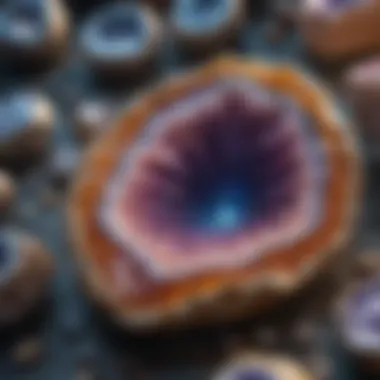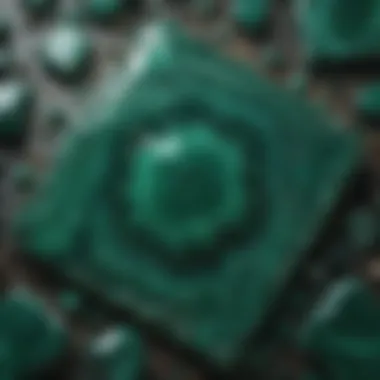Unveiling the Fascinating World of Mineral Tiles: A Comprehensive Exploration


Rock and Fossil Identification
In the exciting realm of mineral tiles, the identification of different types of rocks and fossils is a crucial skill for collectors and enthusiasts to possess. Whether examining sedimentary, igneous, or metamorphic rocks, understanding the unique characteristics of each type is paramount. Identification can be honed through meticulous observation, noting various textures, colors, and mineral compositions. Advanced tools such as magnifying glasses, hardness picks, and streak plates play a vital role in the accurate classification of rocks and fossils.
Collecting Tips and Techniques
When delving into the world of mineral tiles, mastering the art of collecting is key to acquiring valuable specimens. Enthusiasts are advised to adhere to best practices for collecting, which include obtaining necessary permits, respecting private property, and following ethical guidelines. Locating prime collecting sites involves research, networking with local experts, and exploring diverse geological landscapes to maximize the potential of finding exceptional specimens. Properly extracting specimens involves using specialized tools like rock hammers, chisels, and safety goggles to ensure safe and efficient collection.
Preservation and Display
Preserving the beauty and integrity of mineral tiles is essential for their longevity and aesthetic appeal. Utilizing techniques such as cleaning with gentle brushes, stabilizing fragile specimens, and storing in acid-free containers helps maintain their pristine condition. Proper storage methods involve storing rocks and fossils in controlled environments away from direct sunlight, moisture fluctuations, and extreme temperatures. When it comes to creative display ideas, enthusiasts can showcase their collections in custom-built shelving units, shadow boxes, or elegant glass display cases to highlight the unique features and beauty of each specimen.
Geological Insights
Understanding the geological context of mineral tiles adds a fascinating dimension to the collection. Exploring the geological formations and processes that led to the creation of rocks and fossils provides valuable insights into Earth's history and evolution. Recognizing the historical significance of certain rocks and fossils offers a glimpse into past ecosystems, climates, and geological events. Notable discoveries in the field of mineral tiles have contributed significantly to scientific knowledge and have sparked curiosity and awe among collectors and researchers alike.
Understanding Mineral Tiles
Understanding mineral tiles is a pivotal aspect of this comprehensive guide, shedding light on the fundamentals of these remarkable geological formations. Delving into the intricacies of mineral tiles allows enthusiasts, particularly rock and fossil collectors, to grasp the essence of these exquisite creations of nature. By understanding mineral tiles, collectors gain insights into their formation, physical properties, and unique characteristics, providing a holistic view of their significance in the world of geology.
Definition of Mineral Tiles
Mineral tiles, at the core, represent a fusion of minerals and elements that coalesce to form distinctive patterns and structures. Comprehending the composition and structure of mineral tiles unveils a world of diversity and complexity within these geological wonders. The combination of minerals influences the appearance, durability, and overall allure of mineral tiles, making them a sought-after choice in various applications. Exploring the composition and structure of mineral tiles not only enhances the aesthetic appreciation of these formations but also underlines their geological importance.
Composition and Structure
The composition and structure of mineral tiles play a pivotal role in defining their visual appeal and durability. The intricate interplay of minerals determines the color palette, texture, and overall aesthetic of mineral tiles. Understanding the composition and structure provides valuable insights into the origin of mineral tiles, offering a glimpse into the geological processes that shaped these formations. The unique feature of distinct mineral compositions creates a kaleidoscope of hues and patterns, showcasing nature's artistic prowess in crafting these geological masterpieces.
Physical Properties
The physical properties of mineral tiles encompass a spectrum of characteristics that contribute to their uniqueness and desirability. Parameters such as color, texture, and hardness define the visual and tactile experience of interacting with mineral tiles, making them stand out in the world of natural formations. Exploring the nuances of physical properties elucidates the rich diversity present in mineral tiles, captivating collectors with their vibrant hues, intricate textures, and varying degrees of hardness.


Color
Color, as a key physical property of mineral tiles, defines their aesthetic appeal and sets them apart in the realm of geological formations. The spectrum of colors exhibited by mineral tiles reflects the mineral composition, environmental factors, and geological history that converge to create these visual spectacles. Each hue tells a story of geological processes and mineral interactions, providing an immersive experience for enthusiasts and collectors alike.
Texture
Texture serves as a tactile signature of mineral tiles, adding depth and complexity to their visual allure. The unique textures displayed by mineral tiles convey a sense of history and formation, inviting exploration and admiration. From smooth and lustrous surfaces to rough and rugged finishes, the textures of mineral tiles offer a sensory experience that enhances the appreciation of their natural beauty.
Hardness
Hardness, a critical physical property of mineral tiles, influences their durability, resilience, and utility in various applications. Understanding the hardness of mineral tiles enables collectors to assess their suitability for different uses, whether as decorative elements, construction materials, or artistic showcases. The varying degrees of hardness found in mineral tiles underscore their versatility and adaptability, making them valuable assets in geological collections and creative projects.
Formation Process
The formation process of mineral tiles unveils the intricate mechanisms that govern their creation and evolution over time. From crystallization to metamorphism, the journey of mineral tiles reveals a tapestry of geological events and transformations that culminate in their present state. Exploring the formation process provides a glimpse into the dynamic nature of geological processes, highlighting the fascinating interplay of heat, pressure, and mineral interactions that shape mineral tiles.
Crystallization
Crystallization, a fundamental aspect of mineral tile formation, involves the gradual growth and organization of minerals into distinct crystal structures. The process of crystallization imbues mineral tiles with crystalline arrangements that define their visual characteristics and physical properties. By delving into the nuances of crystallization, collectors gain a deeper appreciation for the symmetrical patterns and vibrant hues found in mineral tiles, unveiling the beauty of crystalline formations.
Metamorphism
Metamorphism, a transformative process in mineral tile formation, entails changes in mineral composition and structure due to heat, pressure, and chemical reactions. The phenomenon of metamorphism leads to the recrystallization of minerals and the development of new textures and properties in mineral tiles. Exploring metamorphism offers insights into the dynamic nature of geological transformations, showcasing the adaptability and resilience of mineral tiles in response to external forces.
Locations of Mineral Tiles
In the realm of mineral tiles, understanding their locations is key to unraveling the mysteries they hold. Exploring the varied environments where mineral tiles can be found offers valuable insights into their formation, composition, and significance. By delving into different locations, we can observe the diverse geological settings that contribute to the creation of these captivating natural wonders. From continental crusts to oceanic depths and underground deposits, each location presents a unique tableau of mineral tile formations.
Continental Crust
The continental crust serves as a rich tapestry for mineral tile occurrences, with distinctive zones such as mountain ranges, desert regions, and volcanic areas providing a plethora of mineralogical treasures. Within mountain ranges, mineral tiles are intricately embedded in the geological structures, offering a vivid display of colors, textures, and hardness variations. The rugged terrain of mountain ranges fosters a vibrant mineral ecosystem, attracting enthusiasts and geologists alike to explore its rocky landscapes.


Mountain Ranges
Mountain ranges stand out as geological marvels housing an abundance of mineral tiles waiting to be discovered. Their towering peaks and rugged slopes harbor an array of minerals, showcasing a kaleidoscope of hues ranging from earthy browns to vibrant ochres. The unique geological processes that shape mountain ranges contribute to the formation of diverse mineral compositions, making them a focal point for mineral exploration and study.
Desert Regions
Desert regions, though seemingly barren, conceal a hidden world of mineral tiles beneath their sands. The arid conditions of deserts play a significant role in mineral formation, resulting in unique textures and hardness levels of minerals found in these extreme environments. Desert regions offer a stark contrast to other locations, presenting a chance to unearth rare mineral specimens shaped by the harsh desert climate.
Volcanic Areas
Volcanic areas exude a volcanicverging influence on mineral tile formations, with molten rock giving birth to intricate crystalline structures. The dynamic nature of volcanic landscapes fosters the creation of mineral tiles with vibrant colors and exceptional hardness. Venturing into volcanic areas unveils a mosaic of mineral diversity, underscoring the volatile yet captivating essence of these geologically active regions.
Exploring Unique Mineral Tile Locations
Exploring unique mineral tile locations is a crucial aspect of this insightful article on mineral tiles. By showcasing mineral tiles in various environments, we aim to provide a comprehensive view of their versatility and beauty. The exploration of different locations sheds light on the diverse ways in which mineral tiles form and thrive, offering enthusiasts a deeper understanding of their geological significance and aesthetic appeal.
Mineral Tiles in Arid Regions
Salt Flats
Salt flats represent a captivating facet of mineral tiles due to their distinctive characteristics and abundant mineral deposits. The stark landscape of salt flats, dominated by crystalline formations and salt pans, showcases the unique interplay of minerals in arid environments. Their contribution to the overall topic lies in the rarity and purity of the minerals found in these regions, making them a relevant focal point for our discussion.
Salt flats' key characteristic lies in their expansive salt crusts, which form intricate patterns and textures that mesmerize observers. Their popularity in this article stems from their association with mineral diversity and the therapeutic properties that some minerals exhibit. However, one disadvantage of salt flats is their vulnerability to environmental changes and human exploitation, underscoring the need for sustainable mineral extraction practices in these areas.
Desert Dunes
Desert dunes offer another intriguing dimension to exploring mineral tile locations, with their shifting sands and hidden mineral treasures. These natural formations epitomize the resilience of mineral tiles in harsh desert climates, where minerals interact with wind and sand to create stunning geological formations. Their significance to the overall narrative lies in the role they play in showcasing the adaptability of minerals to extreme conditions, highlighting their ability to thrive in arid landscapes.
The key characteristic of desert dunes is their dynamic nature, constantly reshaped by the elements to reveal buried mineral deposits and ancient geological features. Their allure for this article lies in their geological history and the diversity of minerals that can be found within them. However, a challenge associated with desert dunes is the delicate balance needed to preserve their natural state while allowing for responsible mineral exploration and study.
Mineral Tiles in Tropical Climates


Coral Reefs
Coral reefs present a vibrant and biodiverse setting for mineral tiles, where intricate marine life and colorful minerals coexist in harmony. Their role in the overall theme is centered on the symbiotic relationship between minerals and living organisms, showcasing how mineral tiles contribute to the health and structure of coral ecosystems. The unique feature of coral reefs lies in their coral polyps, which secret (text exceeds limit)
Challenges in Locating Mineral Tiles
In the intricate world of mineral tiles, navigating the challenges of locating these geological marvels is a fundamental aspect that enhances the overall allure of mineral exploration. The significance of understanding and overcoming these challenges cannot be overstated, as it opens up avenues for mineral enthusiasts to unearth rare specimens and study them in their natural habitat. By delving into the hurdles faced in pinpointing mineral tile locations, individuals can expand their knowledge base and contribute to the preservation of these natural wonders.
Accessibility Issues
Remote Areas
Remote areas stand out as key focal points within the realm of mineral exploration. These isolated regions often harbor untouched veins of mineral tiles, offering enthusiasts a glimpse into untouched geological formations. The allure of remote areas lies in their pristine nature, untouched by human interference, allowing for the discovery of unique mineral specimens that have eluded mainstream attention. Despite the challenges posed by accessibility, the remoteness of these areas serves as a protective shield, safeguarding the integrity of these mineral deposits and preserving their natural state.
Protected Sites
Protected sites serve as vital grounds for mineral tile conservation. These areas, designated for their ecological significance, play a crucial role in safeguarding delicate mineral ecosystems from exploitation. By focusing on protected sites, researchers and collectors can ensure the sustainable management of mineral resources for future generations. The stringent regulations governing these sites aim to strike a balance between exploration and preservation, fostering a harmonious coexistence between human activity and environmental conservation.
Environmental Factors
Climate Conditions
Climate conditions exert a profound influence on the formation and preservation of mineral tiles. The unique interplay between temperature, precipitation, and geological processes shapes the mineral composition found in different regions. Understanding the intricate relationship between climate conditions and mineral deposition enhances the prospecting efforts of enthusiasts, enabling them to target regions conducive to mineral formation. While variations in climate may pose challenges, they also offer valuable insights into the diversity of mineral tiles and their adaptability to different environmental conditions.
Natural Disasters
Natural disasters represent a dual-edged sword in the realm of mineral exploration. On one hand, catastrophic events such as earthquakes and volcanic eruptions can unveil hidden mineral deposits, exposing geological riches that were previously concealed. On the other hand, these disasters pose risks to existing mineral formations, threatening their stability and integrity. By examining the impact of natural disasters on mineral tiles, researchers gain a deeper appreciation for the dynamic nature of geological processes and the resilience of mineral deposits in the face of adversity.
Legal Regulations
Mining Laws
Mining laws play a pivotal role in orchestrating mineral extraction activities while upholding ethical standards and environmental protection measures. These regulations serve as guiding principles for mineral exploration, outlining permissible practices and delineating boundaries for sustainable resource utilization. By adhering to stringent mining laws, enthusiasts can mitigate the environmental impact of their activities and contribute to the responsible management of mineral resources. The structured framework provided by mining laws ensures transparency and accountability within the mineral exploration sector, fostering a culture of sustainable development and conservation.
Conservation Policies
Conservation policies form the backbone of mineral preservation initiatives, emphasizing the importance of maintaining ecological balance and biodiversity within mineral-rich regions. These policies promote the conservation of natural habitats and mineral ecosystems, advocating for the protection of endangered species and unique geological formations. By aligning with conservation policies, individuals demonstrate their commitment to environmental stewardship and sustainable resource management. Through proactive conservation efforts, enthusiasts can play a vital role in safeguarding mineral tiles for future generations, nurturing a legacy of biodiversity and geological heritage.







